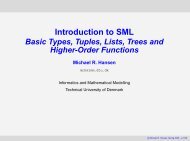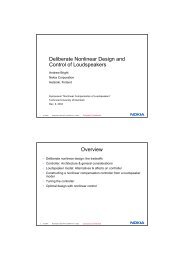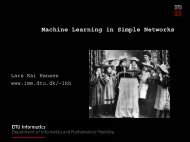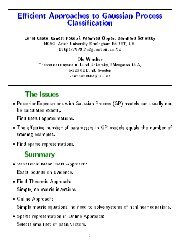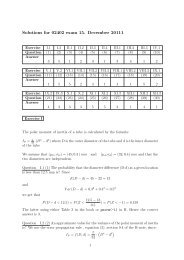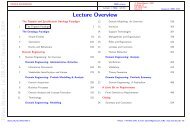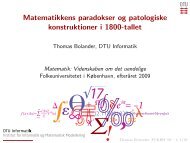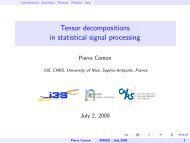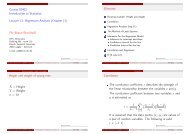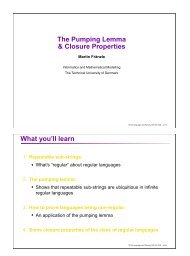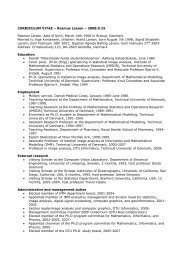Monte Carlo full waveform inversion of tomographic crosshole
Monte Carlo full waveform inversion of tomographic crosshole
Monte Carlo full waveform inversion of tomographic crosshole
You also want an ePaper? Increase the reach of your titles
YUMPU automatically turns print PDFs into web optimized ePapers that Google loves.
<strong>Monte</strong> <strong>Carlo</strong> <strong>full</strong> <strong>waveform</strong> <strong>inversion</strong>3uncertainty with a standard deviation <strong>of</strong> 10 − . Accordingly,the standard deviation <strong>of</strong> the data uncertainties, σ , is set to3. The standard deviation <strong>of</strong> the amplitude noise isindicated by the red error bar in figure 3 and compared withtwo <strong>waveform</strong>s recorded at 0 degrees (short <strong>of</strong>fset / highamplitude) and 45 degrees transmitter-receiver angles (long<strong>of</strong>fset / low amplitude), respectively.1Recorded at short <strong>of</strong>fset0.5Recorded at long <strong>of</strong>fset0-0.5-110 − 100 150 200 250 300 350 400Normalized amplitudeSample no.Figure 3. Dashed line is a <strong>waveform</strong> recorded at shorttransmitter-receiver <strong>of</strong>fset (0 degrees). Solid line is a<strong>waveform</strong> recorded at long <strong>of</strong>fset (45 degrees). The height<strong>of</strong> the red errorbar indicates 2 times the standard deviation<strong>of</strong> the noise added to the data.Depth [m]05100 2 405100 2 405100 2 4Distance [m]05100 2 405100 2 4Figure 4. Five statistically independent samples from the aposteriori probability density <strong>of</strong> the <strong>full</strong> <strong>waveform</strong> inverseproblem.The initial model used for the Metropolis algorithm ischosen as an unconditional sample <strong>of</strong> the training imageusing a different random seed than for the reference model(see figure 2 right). Burn-in was reached after 2000accepted models. Hereafter samples accepted by theMetropolis rule are representative samples <strong>of</strong> the aposteriori probability density. Figure 4 shows the 2000 th ,6000 th , 1000 th , 14000 th , and 18000 th accepted sample usinga priori information defined by the training image (figure 1)and Gaussian data uncertainty (equation 4). Only a slightdeviation between the individual samples is seen, whichindicates little a posteriori model uncertainty. Figure 5shows the a posteriori mean and variance based on 18000samples from the a posteriori probability density after theburn-in period. From the a posteriori variance it is seen thatthe overall structures <strong>of</strong> the model is recovered (varianceclose to or equal to zero) whereas the higher variancesalong the edges between the clay and sand deposits aresubjected to uncertainty. A comparison between thereference model (figure 2 left) and the mean <strong>of</strong> the samples(figure 4 right) confirms that the <strong>waveform</strong> <strong>inversion</strong> is ableto recover the sand structures very well. Moreover, itshould be noted that the algorithm is able to reach theseresults even though it is initiated in a model uncorrelatedwith the reference model (compare figure 2 right and left).Depth [m]0246810Mean120 2 4Distance [m]4.64.44.243.83.63.43.232.82.6( ε/ε 0)0246810Variance120 2 4Distance [m]Figure 5. Mean (left) and variance (right) <strong>of</strong> 18000 samplesdrawn from the a posteriori probability density <strong>of</strong> thesolution to the <strong>full</strong> <strong>waveform</strong> inverse problem.The suggested <strong>Monte</strong> <strong>Carlo</strong> <strong>inversion</strong> strategy is preferablein that it allows for arbitrary antennae geometry.Furthermore, complex a priori <strong>inversion</strong> can be includedusing the perturbed simulation algorithm. Finally, a <strong>full</strong>data covariance matrix can be included in order to accountfor correlated data errors, which are <strong>of</strong>ten present in<strong>tomographic</strong> inverse problems (e.g. Maurer and Musil,2004; Cordua et al., 2008, 2009). However, note that thisexhaustive sampling strategy needs substantially morecomputationally expensive forward calculations comparedto the traditional migration based approach.ConclusionsWe have demonstrated the potential <strong>of</strong> producing samples<strong>of</strong> the solution to a <strong>tomographic</strong> <strong>full</strong> <strong>waveform</strong> inverseproblem using the extended Metropolis algorithm withcomplex a priori information. The methodology provides ameans <strong>of</strong> evaluating the a posteriori uncertainty, which isnot provided using optimisation based strategies for <strong>full</strong><strong>waveform</strong> <strong>inversion</strong>. Moreover, the present approach isrobust with regard to the initial guess <strong>of</strong> the solution and thetransmitter-receiver density. Finally, the extendedMetropolis Algorithm is flexible regarding the choice <strong>of</strong> apriori information and specification <strong>of</strong> data uncertainties.SEG Expanded abstracts0.80.70.60.50.40.30.20.10( ε 2 /ε 02 )



